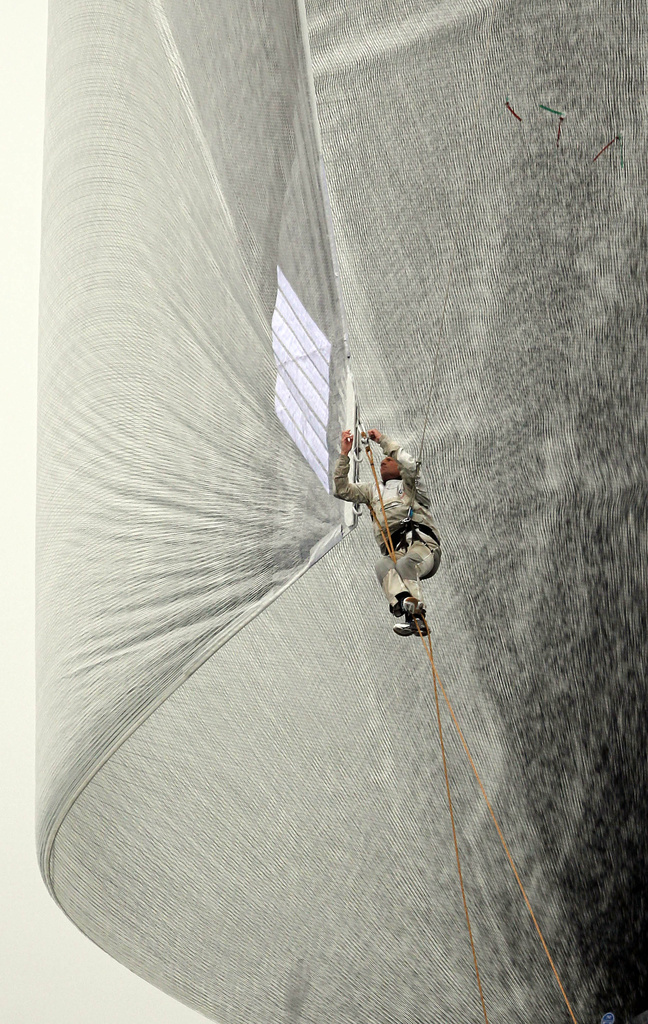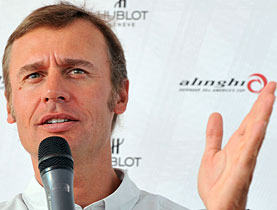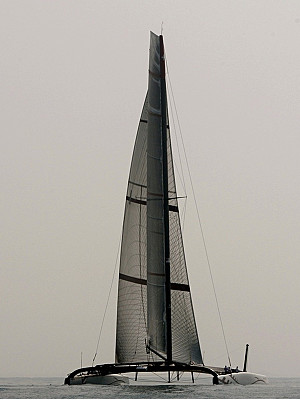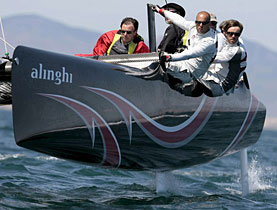America’s Cup is finally set to sail

Yachting’s biggest, most technologically advanced, most expensive – and one of its most bitter – contests will finally splash down on Valencia, Spain in a few days.
The 33rd America’s Cup, contested by Swiss defenders Alinghi and California-based challengers BMW Oracle Racing, will begin on February 8, some 159 years after its first running. It is the oldest continuously awarded trophy in sport.
Much has changed since the wooden yacht America defeated a fleet of British vessels in a race around the Isle of Wight: this time, both teams sail massive multi-hull vessels utilising the latest technology and composite materials.
The Swiss team will be riding a giant catamaran the width of two tennis courts packing a 17-storey mast. Oracle’s boat, USA 17, has three hulls and is powered by a 68-metre-high rigid wing in place of a sail, one that’s 80 per cent longer than the one found on a Boeing 747.
Oracle says the boat can reach speeds of 40 knots (75 km/h) and cut through the water with one hull ten metres in the air.
“It is audacious,” naval architect and sailing insider Marcus Hutchinson says of USA 17’s design. “I think what they’ve done is quite remarkable.”
Audacious and remarkable have also been the three years of legal wrangling, public relations angling and rhetorical barbs traded between the two sides.
Even this week the two sides – sponsoring clubs Golden Gate Yacht Club and the Société Nautique de Genève – were still at odds over rules concerning wind.
What’s more, on Thursday the New York supreme court set a date of February 25 to hear Oracle’s complaint that Alinghi breached America’s Cup rules by having its sails made abroad – meaning an Alinghi victory could be reversed if Oracle wins the court case. Alinghi claims its sails are constructed in Switzerland.
Wealth…
Behind all of this stand two very rich egos: Oracle is led by Silicon Valley tycoon Larry Ellison, the world’s fourth-richest man, fiercely competitive owner of a $200 million (SFr211 million) Japanese-inspired home and partner in the world’s sixth-largest private yacht.
Alinghi is led by Ernesto Bertarelli, an Italian-born, American-educated heir to a pharmaceutical company. Bertarelli, who took over Geneva-based Serono in 1998 after his father died, sold the company in 2006. He is married to a former beauty queen and is worth $8.2 billion.
Bertarelli, 44, who splits his time between the alpine resort of Gstaad and Geneva, said on Wednesday he would helm his own boat.
“I’m going to do it… I think I’m at a sufficient level [of skill and experience] to steer the boat, it’s an honour and a pleasure to do so in this America’s Cup,” he said, quoted by the Valencia-based newspaper Las Provincias.
Oracle will be skippered by Australian James Spithill, although Ellison, 65, could participate as a member of the rear section on USA 17. The team hasn’t made a decision.
…and belligerence
So how did this race go from wooden schooners to boats that look like insects and are the size of apartment buildings?
The rules of the race are spelled out in the Deed of Gift, an 1887 document that’s rather vague when it comes to boat specifications. It calls for vessels to be no longer than 27 metres at the waterline but not much else.
“And you apply that to 2009 or 2010 thinking and ideas, plus the wealth and belligerence of both sides and you end up with these two boats,” Hutchinson told swissinfo.ch.
Both teams were unavailable for comment.
A former communications chief for the America’s Cup, Hutchinson says that although technology has always played an important role in past races, Bertarelli and Ellison have reached a new plateau.
“If it continues on this way, there won’t be any more America’s Cup racing for large numbers of teams,” he said.
Race days
On Thursday the race jury set the start of the series for 10:06am local time and ruled that Alinghi could not set wind limits. Alinghi is thought to have an advantage over its heavier challenger in lighter winds. But with the ability to turn on its centre hull, USA 17 ought to be more nimble.
Hutchinson says that despite the out-of-this-world performance of the two boats, the racing won’t actually be “particularly mind blowing”. Unlike 2007, the 2010 contest has eschewed a qualifying regatta, instead settling on a best-of-three series between the two boats.
With uncertainty so close to the running of the race, organisers have been scrambling. They say the race for the “Auld Mug” will be streamed online for the first time and although it will be broadcast to a potential global television audience of over two billion, no North American television has been struck. The website went online only days ago.
So who’s interested? Three years ago the contest brought millions of people to the shores of Valencia. This time, organisers and hotel operators see things less optimistically – in part because it’s winter. Bertarelli admits the legal troubles have meant “a very big step backwards from the point of view of the event, the public and the sponsors”.
Long-time supporter Louis Vuitton, the luxury goods maker, has set up a rival event.
“To be very honest, the sailing community is just bored by the America’s Cup right now,” Hutchinson said. “Luckily, if the weather is good, it’s not going to take very long.”
Justin Häne, swissinfo.ch
Boat type: Catamaran of carbon composite construction
Builder: Alinghi-Décision in Villeneuve, canton Vaud
Sponsor: Société Nautique de Genève
Overall length: 27 metres
Waterline length: 27 metres
Mast height: 50 metres
Beam: 25 metres
Displacement: 12,000kg
Building time: More than 100,000 hours
Boat type: Trimaran built of carbon composite materials
Builder: Core Builders in Anacortes, Washington
Sponsor: Golden Gate Yacht Club
Overall Length: 30 metres
Waterline Length: 27 metres
Mast height: 58 metres
Beam: 27 metres
Displacement: 16,000kg
Building time: 150,000 hours
The America’s Cup is the oldest and most prestigious trophy in the sport of sailing. It is awarded to the winner of a series of regattas between the defender of the cup and the challenger.
The competition, held for the first time in England in 1851, was won by America, with a boat from the New York Yacht Club. The club held the cup for 132 years until it was beaten in 1983.
By defeating the defending champion, New Zealand, in 2003, Alinghi brought the trophy for the first time to Europe.

In compliance with the JTI standards
More: SWI swissinfo.ch certified by the Journalism Trust Initiative













You can find an overview of ongoing debates with our journalists here . Please join us!
If you want to start a conversation about a topic raised in this article or want to report factual errors, email us at english@swissinfo.ch.